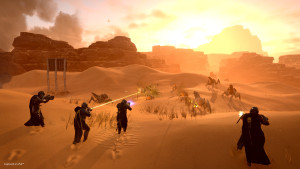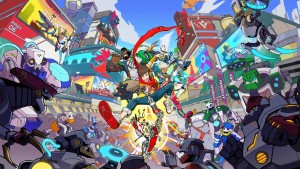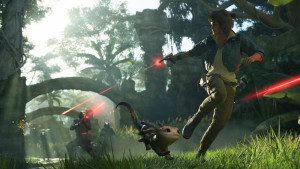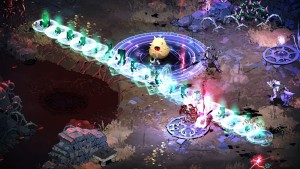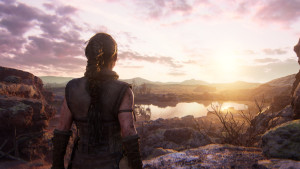Please support Game Informer. Print magazine subscriptions are less than $2 per issue
Battlefield V’s Firestorm Is A Serviceable, But Not Special Battle Royale
When DICE originally announced Battlefield V last May, I was impressed by the studio’s commitment to sticking to its guns with a teamplay-focused competitive multiplayer experience. While Call of Duty jumped on the battle royale bandwagon, DICE seemed to be instead focusing on what made Battlefield special in the first place. That narrative fell apart in the summer when EA announced Battlefield V would be getting its own rendition of the mode Brendan Green popularized with PlayerUnknown’s Battlegrounds and Epic pivoted to with Fortnite.
This week, Firestorm finally parachuted in as the reinforcement the content-starved Battlefield V desperately needs. But in the months since DICE announced plans to join the battle royale battle royale, the competition in the genre is fiercer than ever, with EA’s own Apex Legends exploding on the scene and garnering more than 50 million players in less than 30 days. After playing the mode over the last several days, I think Firestorm is a serviceable battle royale experience with some signature Battlefield elements, but I doubt that will be enough to pull players away from the other games or change the fortune of Battlefield V on its own.
Developed by DICE’s sister studio Criterion, Firestorm makes a few notable changes to the battle royale formula. Criterion leverages Frostbite’s signature destruction capabilities to make arguably the most interesting closing circle in the genre. Rather than just drain health from players caught outside its borders, the firestorm literally burns and destroys everything in its path. This makes the heart-pounding race to escape its fiery clutches all the more thrilling. Destructibility also helps root out building campers. If someone is hunkered down in the top level of a home, a well-placed rocket or artillery can dislodge them from their defensive position.
It wouldn’t be a proper Battlefield mode without a healthy emphasis on vehicular play, and Firestorm has many more vehicles than its competition. You can commandeer tanks, amphibious vehicles, armored trucks, and even a prototype helicopter. The value of the most powerful vehicles like tanks largely depends on whether you have extra ammo or gas to extend their usefulness. Don’t expect to be rolling into the final circle every round with an infinite amount of ammo in your Tiger.
Firestorm supports solo play and squads with up to 64 players, a player count that feels disappointing given the large map size compared the genre’s 100-player standard. Over my dozens of hours spent with the game, a steady rhythm developed as to how most matches played out. As with most battle royale modes, drops often include a furious race to weaponry before other players gather them and turn their sights on you. The herd is often thinned by a good 20 players within the first few minutes of the match. Then, the play typically transitions into a lonely sojourn toward the middle of the hot zone. Criterion tries to entice players into skirmishes during these sequences by placing strategic supply points on the map where players can capture to recover rare items, but even taking these sometimes doesn’t result in an encounter. If the player count was beefed up, perhaps it would feel more lively on the way to the final showdown.
Having more fighters in each round would be nice, but player count isn’t one of the bigger issues holding back Firestorm. My main gripe with the game right now is how long it takes to get into a match. While most battle royale games allow you to quickly start a new round once you are downed, Firestorm has a painfully slow process whereby you need to first wait for your progression stats to tally, find a party if you are playing squads, then load the map, and then wait a bit longer in an unnecessary, PUBG-style instanced lobby where you run around like a moron trying to shoot or stab each other. Given the game already has a practice range for experimenting with guns, this section feels superfluous. Collectively, the wait can take anywhere from three to five minutes on average, which is way too long.
DICE also needs to overhaul Firestorm’s looting system, which everyone under the sun has already astutely pointed out. When you finish off an opponent, loot bursts from their body like a piñata. This moment can look comical, but sorting through the gear is a nightmare because the gear often stacks on itself, making it unnecessarily difficult to sort through the mess. Correcting this problem with an Apex Legends style deathbox seems like an easy improvement, so we hope to see a hotfix soon.
Beyond these standout features and problems, Firestorm isn’t particularly noteworthy. The gunplay is solid. Loot drops seem varied enough and game changers like V1 rockets feel scarce enough as to not dominate matches. The map is beautiful, though it could use more memorable points of interest. I would have liked to see Criterion find a way to make classes matter in battle royale and integrate fortifications, but these exclusions hardly doom the experience.
Firestorm is a competent take on the battle royale genre capable of delivering thrilling moments, but even if Criterion cuts down the time between matches, adds more players, and fixes the loot piñata problem, this mode doesn't distinguish itself enough from the crowded genre to change the fortunes of Battlefield V.





